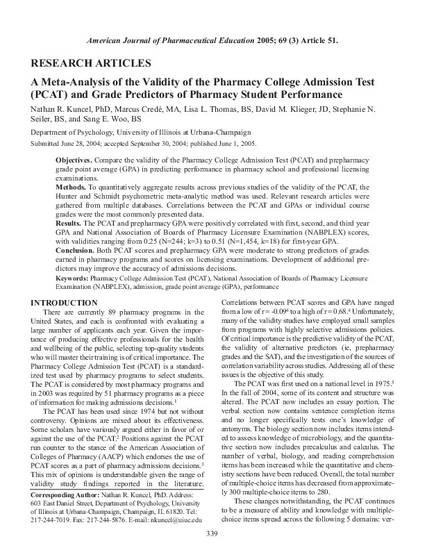
Article
A Meta-Analysis of the Validity of the Pharmacy College Admission Test (PCAT) and Grade Predictors of Pharmacy Student Performance Read More: http://www.ajpe.org/doi/abs/10.5688/aj690351
American Journal of Pharmaceutical Education
(2005)
Abstract
Objectives. Compare the validity of the Pharmacy College Admission Test (PCAT) and prepharmacy grade point average (GPA) in predicting performance in pharmacy school and professional licensing examinations.
Methods. To quantitatively aggregate results across previous studies of the validity of the PCAT, the Hunter and Schmidt psychometric meta-analytic method was used. Relevant research articles were gathered from multiple databases. Correlations between the PCAT and GPAs or individual course grades were the most commonly presented data.
Results. The PCAT and prepharmacy GPA were positively correlated with first, second, and third year GPA and National Association of Boards of Pharmacy Licensure Examination (NABPLEX) scores, with validities ranging from 0.25 (N=244; k=3) to 0.51 (N=1,454, k=18) for first-year GPA.
Conclusions. Both PCAT scores and prepharmacy GPA were moderate to strong predictors of grades earned in pharmacy programs and scores on licensing examinations. Development of additional predictors may improve the accuracy of admissions decisions.
Disciplines
Publication Date
2005
DOI
10.5688/aj690351
Publisher Statement
Copyright 2005 American Journal of Pharmaceutical Education
Citation Information
Nathan R. Kuncel, Marcus Crede, Lisa R. Thomas, David M. Klieger, et al.. "A Meta-Analysis of the Validity of the Pharmacy College Admission Test (PCAT) and Grade Predictors of Pharmacy Student Performance Read More: http://www.ajpe.org/doi/abs/10.5688/aj690351" American Journal of Pharmaceutical Education Vol. 69 Iss. 3 (2005) p. 51 Available at: http://works.bepress.com/marcus-crede/5/
